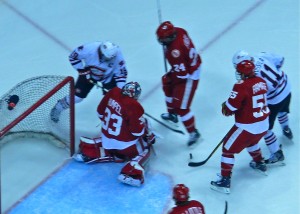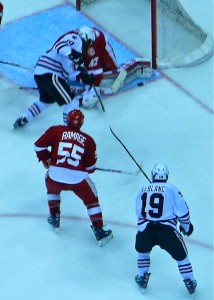Rumpel, Badgers top top-seeded Huskies
By John Gilbert
SAINT PAUL, MINN. — Wisconsin hockey coach Mike Eaves wasn’t ready to say that his Badgers are riding a wave of good karma after they knocked off top-seeded St. Cloud State 4-1 in Friday in the first semifinal of the Red Baron WCHA Final Five tournament.
But it’s as good an explanation as any. The Badgers (21-12-7) had sidetracked Minnesota State-Mankato in a 7-2 shocker in Thursday’s quarterfinals, while St. Cloud State, as league champion, had a bye into the semifinals. The Huskies outshot Wisconsin 31-21, but goaltender Joel Rumpel was more than just solid, with 30 saves in a performance that defused the Huskies offense. The Badgers now face upstart Colorado College, which upset No. 2 seed Minnesota in Friday’s second semifinal.
“I don’t know how you feel about karma,” said Eaves, “but all I know is at the start of the season, we didn’t have much of it.”
St. Cloud State coach Bob Motzko was more pragmatic in his assessment of the Badgers. “They’re pretty banged up, with some of their top players hurting, but as the game went on, they got stronger,” said Motzko. “They’re just dialed in right now. I don’t think we played poorly; they were wearing down in the second period, I felt, but in a game like that, a couple little mistakes can hurt you.”
The Badgers started the season 1-7-3, have gone 19-5-4 since then, on a defensively focused roll that has created more offensive possessions, and carries them into Saturday’s 7 p.m. playoff championship game against the winner of Friday night’s Minnesota-Colorado College game. But the Badgers now are playing with confidence at the offensive end of the rink, too.
But at Xcel Energy Center, there also have been a momentum-generating run of good luck. Against Mankato, the Badgers got a major penalty and scored short-handed, and when Mankato got a major penalty, the Badgers scored on the power play. That sort of thing continued Friday, as a controversial call that could have given St. Cloud State a 2-1 lead instead went Wisconsin’s way. From that point on, the Badgers broke the 1-1 tie on John Ramage’s power-play blast in the second period, and prevented any ideas of a Huskies comeback when Nic Kerdiles and Tyler Barnes added third-period goals — Kerdiles on a power play and Barnes into an empty net at the end.

Badger goaltender Joel Rumpel blocked Drew LeBlanc's attempt in the 4-1 victory over No. 1 seeded St. Cloud State.
Being rested and ready is no guarantee at Final Five time, and the Badgers continued riding the positive vibes against St. Cloud State. After killing an early penalty, the Badgers took a 1-0 lead on a startling play when Joseph LaBate carried across the Huskies blue line and surprised goaltender Ryan Faragher with a 50-foot missile just past a screening defenseman. The shot caught the lower right and Wisconsin led 1-0 at 10:46.
The goal seemed to awaken the Huskies, who responded with a power play goal four minutes later. Nic Dowd, who seemed to be involved in almost all the big plays all game, rushed up the left and passed to the slot. His pass skimmed just past Jonny Brodzinski, which may have decoyed goalie Joel Rumpel, because it got through to Ben Hanowksi, whose quick, low blast went right in.
That set the stage for the biggest controversy of the tournament. St. Cloud State appeared to be on the verge of taking a 2-1 lead when Jimmy Murray carried up the right side of a 2-on-1 and shot. Rumpel made the save, but the the rebounding puck in the slot. Dowd, one of the Huskies top guns, pounced on the loose puck and shot from 10 feet, toward the middle of the open net. Rumpel, scrambling to cover, pivoted to his right but had no chance to get in the way, so he let his big goal stick slip from his grasp, diagonally back toward the far post.
By a remarkable bit of “puck luck,” Dowd’s shot hit the handle of the perfect trajectory of the sliding stick — just enough to deflect the puck wide to the left by about a half inch. Dowd, who started to raise his arms to celebrate the obvious goal, instead grasped his helmet in disbelief.
Huskies coach Bob Motzko, seeing the replay on the big video screen, had a long discussion with the officials, who finally agreed to consult with the video review staff upstairs. The rule book says when any defensive player throws their stick to deflect a puck that is obviously going into the net, it shall be ruled a goal. In this case, incredibly, the decision was “no goal,” with the explanation that a St. Cloud State player had knocked Rumpel’s stick from his grasp. Repeated video views indicated that the goaltender was not touched as he pivoted to his right, coincidentally holding his stick firmly until the perfect time to slide it into the path of the rebound shot.
In the post-game press conference, Rumpel put it in perfect perspective. “It was a weird play,” he said. “I made the first save, then I kind of dove, and knocked it out. The puck hit the knob of my stick.”
Are you saying a St. Cloud player knocked the stick out of your hand?
“No, no player hit my stick,” Rumpel said. “The puck hit my stick and went wide.”
At that point, a 2-1 St. Cloud State lead would have been an enormous lift for the Huskies, and an enormous hit on the Badgers karma. But disallowing it reversed both those possibilities.
“It could have been the turning point in the game, no question about it,” said Eaves.
The teams traded later power plays in the first period, but it stayed 1-1 until the second. Taylor Johnson went off for hooking, and Ramage bombed a pass from Nic Kerdiles in for his power-play goal at 2:08 for what would prove to be the game-winning goal.
“I saw Nic going down the wall so I moved in,” said Ramage, Wisconsin’s only senior defenseman. “Nic made an unbelievable pass to me and I don’t know if my shot hit something or not.”
It did appear to glance off something on the way, but for sure it hit the net.
St. Cloud State increased its shot frequency with a 15-5 edge in the second period, but Rumpel was outstanding. “St. Cloud State had the tempo and pace early,” said Eaves, “but Joel stopped some good scoring opportunities and gaves us a chance to get our legs underneath us.”
Kerdiles and Ramage swapped roles in the third period, after Tim Daly was given a 5-minute checking from behind penalty and game misconduct, just when it appeared the Huskies momentum might find the equalizer. Instead, at 10:29, just 13 seconds into the major penalty, Ramage cut loose from center point and Kerdiles deflected it past goaltender Ryan Faragher for a 3-1 cushion.
“We thought we were in good position,” said Hanowski. “It was 2-1, then we got that major, and they came out and scored right away to make it 3-1. That was pretty deflating.”
Motzko pulled Faragher with a minute and a half to go, but Barnes hit the empty net with 1:11 left for the 4-1 cushion. The game was essentially over, but not the karma. Ryan Little of the Badgers was penalized 5 minutes for checking from behind and a game misconduct. When the Huskies got a major, the Badger power play put the game away; when the Badgers got a major, only 50 seconds remained and it was anti-climactic.
Talk about dialed in.
Comments
Tell me what you're thinking...
and oh, if you want a pic to show with your comment, go get a gravatar!



 John Gilbert is a lifetime Minnesotan and career journalist, specializing in cars and sports during and since spending 30 years at the Minneapolis Tribune, now the Star Tribune. More recently, he has continued translating the high-tech world of autos and sharing his passionate insights as a freelance writer/photographer/broadcaster. A member of the prestigious North American Car and Truck of the Year jury since 1993. John can be heard Monday-Friday from 9-11am on 610 KDAL(www.kdal610.com) on the "John Gilbert Show," and writes a column in the Duluth Reader.
John Gilbert is a lifetime Minnesotan and career journalist, specializing in cars and sports during and since spending 30 years at the Minneapolis Tribune, now the Star Tribune. More recently, he has continued translating the high-tech world of autos and sharing his passionate insights as a freelance writer/photographer/broadcaster. A member of the prestigious North American Car and Truck of the Year jury since 1993. John can be heard Monday-Friday from 9-11am on 610 KDAL(www.kdal610.com) on the "John Gilbert Show," and writes a column in the Duluth Reader.